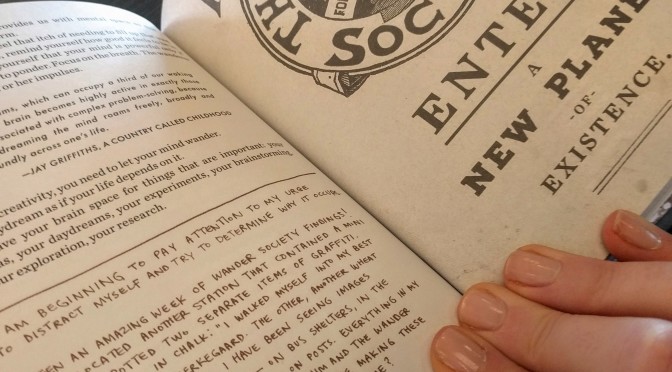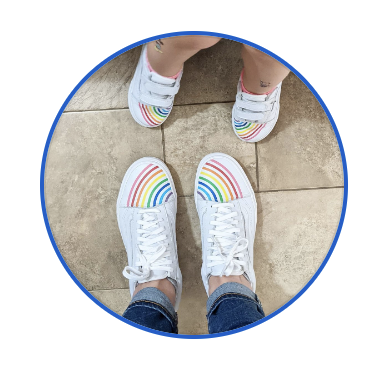This post may contain affiliate links. Every link is hand-selected by our team, and it isn’t dependent on receiving a commission. You can view our full policy here.
Nearly eight years after I first reviewed Keri Smith’s The Wander Society, I was surprised to find…the book has become incredibly polarizing. A number of one-star reviews dismiss it as being “gushy, new agey twaddle” or, by and large, “silly” and “pretentious.” Others consider it a new guide to life.
To me, it was an enchanting, playful take on forest bathing, or walking meditation; a fun read that inspired me to be a bit more curious about everyday life. So why did it piss people off? What is the Society even about? But first, let me back up a bit.
What Is The Wander Society?
In Smith’s book, the narrator finds cryptic writing in the margin of a used copy of Walt Whitman’s Leaves of Grass, leading her to an anonymous group that uses wandering and exploring as methods to reconnect with nature, with themselves and the world at large.

Wait, So Is The Society Real?
No…and yes. It’s a work of fiction designed to get you to suspend disbelief and look at the world around you with fresh eyes. But as people got into the story itself and started taking on the challenges presented in the book, they’re essentially becoming Wander Society members themselves, bringing the group to life. (Even more so if you join the author’s private Facebook group for the society.)
What Upsets People About It?
For some, it was the fact that it was a fictitious group presented as nonfiction. For many, it was the how the book name-dropped Whitman and other authors while presenting the group with a certain smugness about the importance of their mission. Admittedly, the tone could feel pretentious at times, as you sifted through the pretend documents of the organization.
But Here’s Why I Still Love It:
I appreciate the whimsy in this book. Kind of like how geocaching makes you feel part of a group of fellow explorers of everyday life, there’s a certain charm in imagining a group dedicated to such pursuits. Truly—joining The Wander Society is simple: You just decide to spend time wandering, silencing your cell phone and exploring an area near you. There are no group meetings or official tasks (though the book encourages you to create zines, wheat-paste posters and little messages that you hide, geocache-style, for other Wanderers to find).
It leans on the concepts of shinrin-yoku, or forest bathing, as well as the Norweigan concept of friluftsliv—unplugging and connecting with nature—without explicitly saying so. Even if you don’t buy into The Wander Society concept, taking its practices to heart could be beneficial for you. After all, studies have shown forest bathing—essentially, taking walks through nature, being present in the moment—friluftsliv-style exploring can reduce stress, anger and depression while improving sleep.
Personally, I think it appealed to my inner storyteller. As a kid, I had a reputation for pacing the backyard, talking to myself. I’d carry a book in my hands sometimes, pretending to read out loud, when really, I wasn’t looking at a single word on the page. I just didn’t want people to think I was crazy. (Yup, even at 6 or 7, I knew wandering around and talking to myself was frowned upon by modern society.)

I was actually making up elaborate stories. I found talking them out to be way more satisfying than attempting to write them down; my hands couldn’t keep up with the string of thoughts hurtling through my mind. This way, I could revise, edit and alter my plot without bothering with an eraser or obsessing over word choice.
As I grew older, I’d go on walks to sift through a problem. Something about the act of walking helped clear my mind and untangle the issue.
It’s so tempting, these days, that even if we take the time to walk, we’re on the phone. Or listening to a podcast. Or finding some way to multitask. That’s part of the book’s (practical) magic—it offers a few simple practices to help you become more present on your walk.
What Does It Mean to Wander, Anyway?
Here are three of the activities the book suggests to help you wander more mindfully:
- Psychogeography — Grab a map of your town and open it up. Place a cup somewhere on it and trace the mouth of the cup, forming a circle. Explore that area fully.
- Color Tracking — Choose one color in particular, then go for a walk and look for any objects in that color. Log what you find.
- Library Wandering — Head to your nearest library, and ask the librarian what his/her favorite book is. Read that. Or pick up a book you love and look at the bibliography. Pick a book listed there and read it.
Basically, the whole goal is to look at the ordinary—the things you take for granted, as you fly through your to-do list and other obligations—in a whole new light.
As The Wander Society says, Solvitur Ambulando! (It is solved by walking!)
This post was originally published on March 26, 2016, as part of Life Between Weekends’ Tuesday Takeaway series. Every Tuesday, we shared the most compelling insight we’ve gleaned from a book, movie, tour, documentary or article to inspire you during the workday. Though that series has been paused, we still run posts like these on Mondays.





Comments
8 responses to “What Is ‘The Wander Society,’ Anyway? And Is It Real?”
it is real.
Totally an Awesome Post. Back in May I was riding my bicycle over in IL going from Edwardsville to Staunton, and saw a cool note from The Wander Society… Piqued my interest. Love your post and it has pushed me to buy the book. I Love being outside and just seeing the world. Thanks,
My friend and I were wandering when we found a “fairy village” ad a scroll inviting us to join in. I think I always HAVE been a member!!!
That’s so cool! What an awesome find.
Hello,
I am a film student and I would like to make a documentary about TWS. To be it is a secret that invited others to join. And I would love to contact a few wanders in Perth, Western Australia to part take in my documentary.
Please contact me on bly@our.ecu.edu.au.
Thanks for the message, Van! We’re based in the U.S., but I will certainly spread the word to see if I can find anyone in Perth! -Candace
Attempting to view the call to action 2 pdf on website. Can anybody help? I know the symbol but that isn’t working for the password.
it is a taken from the Buddhist practice of 2nd generation naming